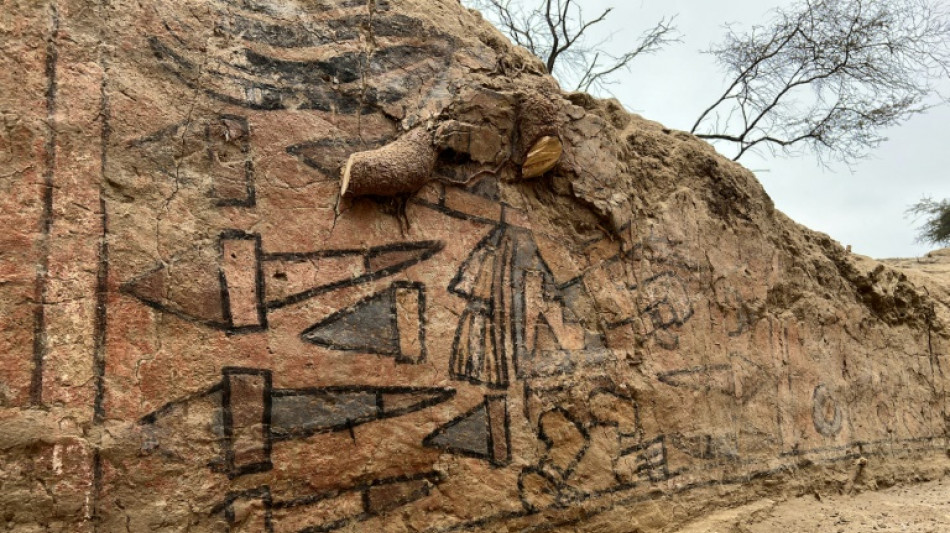
-
 Jordanian, Qatari envoys hold talks with Syria's new leader
Jordanian, Qatari envoys hold talks with Syria's new leader
-
France's second woman premier makes surprise frontline return

-
 France's Macron announces fourth government of the year
France's Macron announces fourth government of the year
-
Netanyahu tells Israel parliament 'some progress' on Gaza hostage deal

-
 Guatemalan authorities recover minors taken by sect members
Guatemalan authorities recover minors taken by sect members
-
Germany's far-right AfD holds march after Christmas market attack

-
 Serie A basement club Monza fire coach Nesta
Serie A basement club Monza fire coach Nesta
-
Mozambique top court confirms ruling party disputed win

-
 Syrian medics say were coerced into false chemical attack testimony
Syrian medics say were coerced into false chemical attack testimony
-
NASA solar probe to make its closest ever pass of Sun

-
 London toy 'shop' window where nothing is for sale
London toy 'shop' window where nothing is for sale
-
Volkswagen boss hails cost-cutting deal but shares fall

-
 Accused killer of US insurance CEO pleads not guilty to 'terrorist' murder
Accused killer of US insurance CEO pleads not guilty to 'terrorist' murder
-
Global stock markets mostly higher

-
 Not for sale. Greenland shrugs off Trump's new push
Not for sale. Greenland shrugs off Trump's new push
-
Acid complicates search after deadly Brazil bridge collapse

-
 Norwegian Haugan dazzles in men's World Cup slalom win
Norwegian Haugan dazzles in men's World Cup slalom win
-
Arsenal's Saka out for 'many weeks' with hamstring injury

-
 Mali singer Traore child custody case postponed
Mali singer Traore child custody case postponed
-
France mourns Mayotte victims amid uncertainy over government

-
 UK economy stagnant in third quarter in fresh setback
UK economy stagnant in third quarter in fresh setback
-
African players in Europe: Salah leads Golden Boot race after brace

-
 German far-right AfD to march in city hit by Christmas market attack
German far-right AfD to march in city hit by Christmas market attack
-
Ireland centre Henshaw signs IRFU contract extension

-
 Bangladesh launches $5bn graft probe into Hasina's family
Bangladesh launches $5bn graft probe into Hasina's family
-
US probes China chip industry on 'anticompetitive' concerns

-
 Biden commutes sentences for 37 of 40 federal death row inmates
Biden commutes sentences for 37 of 40 federal death row inmates
-
Clock ticks down on France government nomination

-
 Mozambique on edge as judges rule on disputed election
Mozambique on edge as judges rule on disputed election
-
Mobile cinema brings Tunisians big screen experience

-
 Honda and Nissan to launch merger talks
Honda and Nissan to launch merger talks
-
Police arrest suspect who set woman on fire in New York subway

-
 China vows 'cooperation' over ship linked to severed Baltic Sea cables
China vows 'cooperation' over ship linked to severed Baltic Sea cables
-
Australian tennis star Purcell provisionally suspended for doping

-
 Luxury Western goods line Russian stores, three years into sanctions
Luxury Western goods line Russian stores, three years into sanctions
-
Wallace and Gromit return with comic warning about AI dystopia

-
 Philippine military says will acquire US Typhon missile system
Philippine military says will acquire US Typhon missile system
-
Afghan bread, the humble centrepiece of every meal

-
 Honda and Nissan expected to begin merger talks
Honda and Nissan expected to begin merger talks
-
'Draconian' Vietnam internet law heightens free speech fears

-
 Israeli women mobilise against ultra-Orthodox military exemptions
Israeli women mobilise against ultra-Orthodox military exemptions
-
Asian markets track Wall St rally as US inflation eases rate worries

-
 Tens of thousands protest in Serbian capital over fatal train station accident
Tens of thousands protest in Serbian capital over fatal train station accident
-
Trump vows to 'stop transgender lunacy' as a top priority

-
 'Who's next?': Misinformation and online threats after US CEO slaying
'Who's next?': Misinformation and online threats after US CEO slaying
-
Only 12 trucks delivered food, water in North Gaza Governorate since October: Oxfam

-
 Beyond Work Unveils Next-Generation Memory-Augmented AI Agent (MATRIX) for Enterprise Document Intelligence
Beyond Work Unveils Next-Generation Memory-Augmented AI Agent (MATRIX) for Enterprise Document Intelligence
-
Langers edge Tiger and son Charlie in PNC Championship playoff

-
 Explosive batsman Jacobs gets New Zealand call-up for Sri Lanka series
Explosive batsman Jacobs gets New Zealand call-up for Sri Lanka series
-
Holders PSG edge through on penalties in French Cup


Archeologists find ancient Peruvian fresco, lost for a century
Archeologists have rediscovered a pre-Hispanic fresco depicting mythological scenes in northern Peru that they had only seen in black and white photographs that were more than a century old.
"It's an exceptional discovery, first of all, because it is rare to unearth wall paintings of such quality in pre-Colombian archeology," said Sam Ghavami, the Swiss archeologist who led excavations that uncovered the mural in October.
Ghavami spent four years looking for the rock painting, which he believes could be around 1,000 years old, with a team of Peruvian students.
"The composition of this painting is unique in the history of mural art in pre-Hispanic Peru," added the archaeologist, who trained at the University of Freiburg in Germany.
The fresco forms part of the Huaca Pintada temple, which belonged to the Moche civilization that flourished between the 1st and 8th centuries, and venerated the Moon, the rain, iguanas, and spiders.
The uncovered mural is about 30 meters (98 feet) long, and its images in blue, brown, red, white, and mustard yellow paint remain extremely well preserved.
In one section, a procession of warriors can be seen heading toward a birdlike deity.
The painted images "appear to be inspired by the idea of a sacred hierarchy built around a cult of ancestors and their intimate links with the forces of nature," said Ghavami.
He told AFP that deciphering the mural's message would form part of his research, but he believes it "could be interpreted as a metaphorical image of the political and religious order of the region's ancient inhabitants."
The discovery is also unusual as it shows a mixture of styles and elements of two pre-Incan cultures: the Moche and the Lambayeque, who lived on Peru's north coast between 900 and 1350 AD.
The mural's existence was only known via black and white photos taken in 1916 by the German ethnologist Hans Heinrich Bruning, who was living in Peru when he heard of the site after treasure hunters tried to loot it, but found nothing of value.
As the years went on, thick foliage took over, and no one had tried to look for the paintings until it piqued Ghavami's interest and he went in search of the long-lost fresco.
However, first he had a long battle to obtain permission from the family who own the land where the mural was found.
L.Torres--PC


